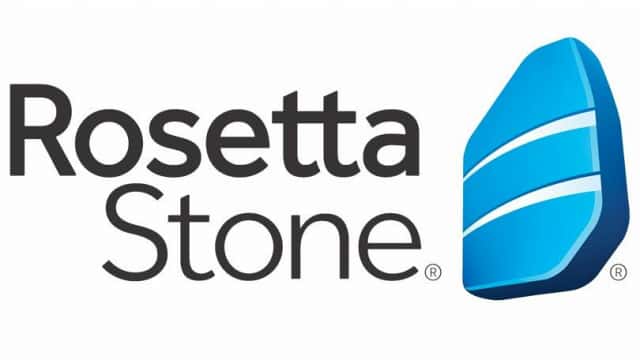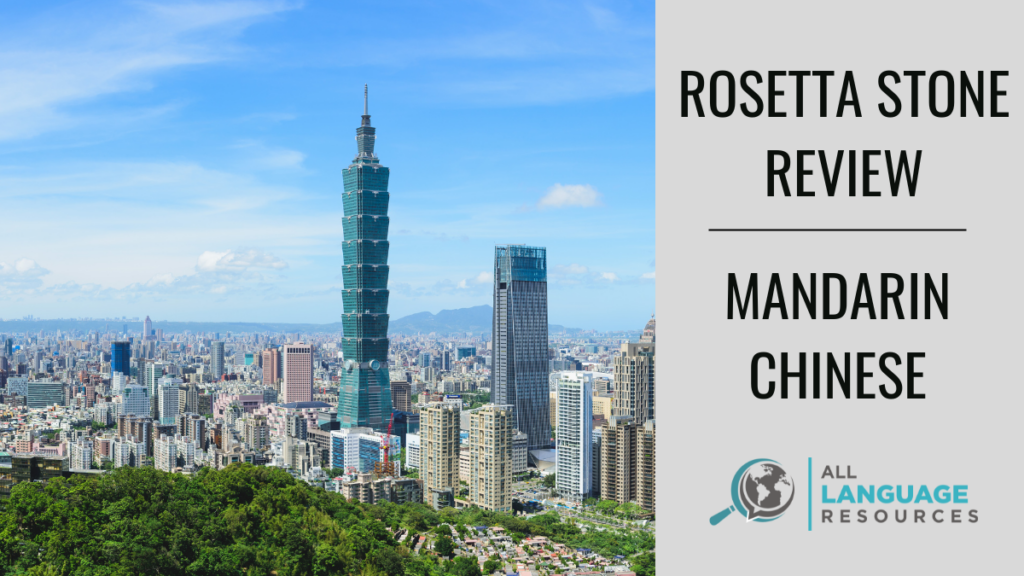Rosetta Stone Mandarin Chinese

Summary
Rosetta Stone is one of the most well-known resources for learning languages. It takes an immersive approach to teaching and is widely used by corporations and individuals alike. High levels of repetition and an absence of translations or explanations are hallmarks of the course. Rosetta Stone course could be most suitable for learners that don’t mind repetitive exercises and prefer to learn from pictures and context rather than translations and explanations. It’s probably not a good option for anyone wanting to significantly improve their speaking or writing skills, or those looking for an engaging course.
The platform is a bit clunky on desktop, but the material is accurate and presented clearly; lesson mechanics are fairly intuitive.
Without much opportunity to build your own sentences, I don’t think you’ll reach a conversational level with any notable speed.
Rosetta Stone’s Lifetime Subscription ($199 on sale) is quite attractive if you like the Rosetta Stone Method. Shorter subscriptions are quite reasonable, too.
I Like
- The audio quality is very good.
- Lessons progress naturally and logically.
I Don’t Like
- It’s repetitive and boring.
- You don’t get to generate your own sentences.
- Speech recognition doesn’t work very well.
- No grammar explanations in core material.
Price
A three-month subscription to one language is $35.97, which works out to be $11.99/month.
A year-long subscription to one course is $95.88, which is $7.99/month. Both of these subscriptions are automatically recurring.
Lifetime access to all Rosetta Stone language courses is available for $199.
ALR Readers Exclusive Holiday Deal!! Get the Lifetime Subscription for 25 languages for $179 (everywhere else it’s $199 right now!). See details on the website.
Rosetta Stone Chinese is a language learning software program that is designed to teach Mandarin Chinese to beginners. It uses an immersive approach to language learning, which means that the program teaches new vocabulary and grammar through pictures, audio, and context, rather than providing translations. Rosetta Stone Chinese focuses heavily on pronunciation, using voice recognition technology to help learners improve their speaking skills. The program is designed to be interactive and engaging, with a variety of exercises and activities to reinforce learning. Rosetta Stone Chinese is available as a subscription service and can be accessed on a variety of devices including computers, smartphones, and tablets.
Your Mandarin Chinese Learning Objectives, the Program’s Strengths and Weaknesses
Before buying Rosetta Stone to learn Chinese, there are several factors you should consider:
- Your learning goals: Consider why you want to learn Chinese and what your goals are. Are you looking to learn basic conversational skills for travel, or do you want to become proficient in reading and writing Chinese hanzi (characters)?
- Learning style: Rosetta Stone Chinese uses an immersive approach to language learning that focuses on pictures, audio, and context, which may not be suitable for everyone. Consider if this style of learning is compatible with your preferred learning style.
- Budget: Rosetta Stone Chinese can be expensive compared to other language learning resources. Consider if the cost is within your budget and if you are willing to invest in a subscription.
- Time commitment: Learning a new language requires time and commitment. Consider if you have the time to dedicate to regular practice and study.
There are some potential drawbacks to using Rosetta Stone Chinese. One is the lack of grammar instruction, which some learners may find frustrating. The program focuses heavily on vocabulary and pronunciation but does not offer much guidance on how to put those elements together into meaningful sentences and conversations. At a very basic level, this is not the end of the world because Chinese word order matches English. For example, the Chinese sentence “I eat pizza” is 我吃披萨 where “我” means “I”, “吃” means “eat” and “披萨” means pizza. So, the words are in the same order as English. However, as your language becomes more fluent, you will want to use parts of speech such as particle, which don’t exist in English and so can’t fit fluidly into an English-structured sentence.
Another concern is the cost of the program, which can be quite high compared to other language learning resources. The cost of Rosetta Stone depends on several factors such as the language being studied, the duration of access, and the type of subscription. For instance, the cost of an annual subscription for Rosetta Stone Chinese ranges from around $119 to $299 depending on the plan and promotions available at the time of purchase. However, it is worth noting that Rosetta Stone often offers discounts and special deals, so it’s a good idea to check their website or promotional emails for the latest pricing information. Additionally, Rosetta Stone also offers a free trial to new users to try the program before committing to a subscription.
However, there are also some strengths to using Rosetta Stone to learn Mandarin Chinese. One of the most notable features of Rosetta Stone Chinese is its immersive approach to language learning. Rather than providing translations, the program uses pictures and audio to teach new vocabulary and phrases in context. This can be a very effective way to learn a language, as it encourages learners to think in the language rather than translating from their native language.
Another strength of Rosetta Stone Chinese is the emphasis on pronunciation. The program uses voice recognition technology to help learners improve their pronunciation and provides immediate feedback on their progress. This is an especially important aspect of learning Chinese, which has a tonal system that can be difficult for non-native speakers to master.
Furthermore, Rosetta Stone Chinese does teach reading Chinese characters. The program introduces learners to Chinese characters gradually, starting with basic characters and building up to more complex ones. It uses a combination of pictures, audio, and context to help learners associate characters with their meanings and pronunciation. In addition, the program provides practice exercises and activities that reinforce character recognition and reading skills. However, it is worth noting that learning to read and write Chinese characters is a challenging task that requires significant time and effort, and Rosetta Stone Chinese is just one tool that can be used to support this learning process.
Rosetta Stone Chinese is a good resource, but is it right for you? Take a look at this alternative Rosetta Stone Mandarin Review that we recommend to help you decide if it caters to your language learning needs.
Alternatives to Rosetta Stone Mandarin Chinese
If your main focus is on being able to read and write characters, you may wish to consider StoryLearning rather than Rosetta Stone. The story learning technique involves using stories to learn and remember new vocabulary and grammar structures. The idea is that by hearing or reading a story, learners can absorb new words and structures in context, which makes them easier to remember and use later. You will also learn to associate the simplified Chinese characters with the words you hear. To use story learning to learn Mandarin, StoryLearning offers stories in Mandarin, along with translations and explanations of new vocabulary and grammar structures. Learners can listen to the stories, read them, and interact with the materials to reinforce their learning. At the time of writing, Story Learning offers two courses – one at HSK 1 level (absolute beginner) and one at HSK 2 level (beginner.)
If your focus is on spoken Mandarin, you might consider using the Pimsleur app. Pimsleur is a well-regarded language learning program that is known for its focus on oral language skills and its use of audio-based lessons. Many learners have found Pimsleur to be effective for learning Mandarin, particularly for developing speaking and listening skills. Mandarin is well known for being difficult due to its tone system (the pitch you put on a word can change its meaning) and so a focus on an audio program will be useful for those wanting to primarily speak Mandarin. However, it’s worth noting that Pimsleur’s approach is focused primarily on spoken Mandarin and may not be as effective for developing reading and writing skills or for learning more advanced grammar structures.
If you want a more balanced curriculum, then ChineseClass101 might be for you. ChineseClass101 is an online language learning platform that offers a variety of resources and tools for learners who want to study Mandarin Chinese. The program offers a structured curriculum that covers a range of topics, including grammar, vocabulary, and pronunciation, and provides learners with opportunities to practice their skills through interactive exercises and quizzes. Many learners have found ChineseClass101 to be a useful tool for learning Mandarin, particularly for developing listening and speaking skills. The program offers a range of audio and video lessons that are designed to be engaging and entertaining, making it easier for learners to stay motivated and engaged with the language. In addition, ChineseClass101 offers a variety of tools and resources to support learning, including flashcards, wordlists, and a mobile app that allows learners to study on-the-go.
Final Thoughts
Overall, Rosetta Stone Chinese is a solid language learning program that can be effective for beginners who want to learn Mandarin Chinese. The immersive approach, emphasis on pronunciation, and user-friendly interface make it an appealing choice for many learners. However, the lack of grammar instruction and high cost may be deterrents for some.
Related Articles:

